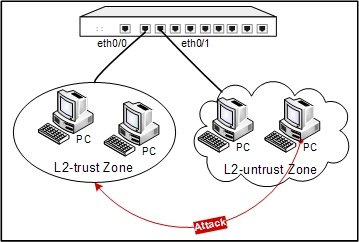Layer 2 IP Address Spoof Defense Configuration Example
This section describes a Layer 2 IP address spoof defense configuration example.
Ethernet 0/0 is bound to the l2-trust zone, and ethernet 0/1 is bound to the l2-untrust zone.
The defense networking topology is shown as follows:

Take the following steps:
Step 1: Create an address book.
-
Select Objects > Address Book from the menu bar.
- In the Address Book dialog, click New. In the Address Entry Configuration dialog, configure the options as below:
- Name: l2-ip-spoof
- Select IP/netmask from the Member drop-down list
- Type 192.168.1.0 and 24 into the IP address and Netmask box respectively, and then click Add.
- Click OK to return to the Address Book dialog.
- Click
 to close the dialog.
to close the dialog.
Step 2: Configure ethernet0/0 and ethernet0/1.
- On the Navigation pane, click Configure > Network > Network to visit the Network page.
- Select ethernet0/0 from the interface list, and click Edit. In the Interface Configuration dialog, configure the options as below:
- Name: ethernet0/0
- Binding zone: Layer 2 zone
- Zone: Select l2-trust from the drop-down list.
- Click OK to save the changes and return to the main page.
- Select ethernet0/1 from the interface list, and click Edit. In the Interface Configuration dialog, configure the options as follows:
- Name: ethernet0/1
- Binding zone: Layer 2 zone
- Zone: Select l2-untrust from the drop-down list.
- Click OK to save the changes and return to the main page.
Step 3: Configure a policy rule.
- On the Navigation pane, click Configure > Security > Policy to visit the Policy page.
- Click New. On the Basic tab in the Policy Configuration dialog, configure the options as below:
- Src zone: l2-untrust
- Dst zone: l2-trust
- Src address: Any
- Dst address: Any
- Service: Any
- Action: Permit
- Click OK to save the settings and return to the main page.
Step 4: Enable Layer 2 IP address spoof defense for the l2-untrust zone.
- On the Navigation pane, click Configure >Security > Attack Defense to visit the Attack Defense page.
- Select l2-untrust from the Zone drop-downl list.
- In the Scan/spoof defense section, select the IP address spoof check box to enable IP address spoof defense.
- Click OK to save the changes.
Step 5: Craft an IP or ARP packet on a PC in the l2-untrust zone, set the source IP address to 192.168.1.100, and send it to ethernet0/1. The device will detect an IP address spoof or ARP attack, and then give an alarm and drop the packet.

